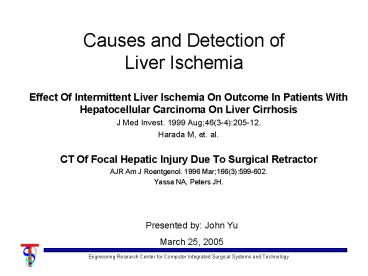Causes and Detection of Liver Ischemia - PowerPoint PPT Presentation
1 / 15
Title:
Causes and Detection of Liver Ischemia
Description:
Typically caused by Clamping liver during liver surgery or ... Intermittent normothermic ischemia (15 min clamped, 5 min unclamped) may be ... – PowerPoint PPT presentation
Number of Views:123
Avg rating:3.0/5.0
Title: Causes and Detection of Liver Ischemia
1
Causes and Detection of Liver Ischemia
- Effect Of Intermittent Liver Ischemia On Outcome
In Patients With Hepatocellular Carcinoma On
Liver Cirrhosis - J Med Invest. 1999 Aug46(3-4)205-12.
- Harada M, et. al.
- CT Of Focal Hepatic Injury Due To Surgical
Retractor - AJR Am J Roentgenol. 1996 Mar166(3)599-602.
- Yassa NA, Peters JH.
Presented by John Yu March 25, 2005
2
Smart Organ Retractor ProjectMentors Greg
Fischer and Mark Talamini, MDPartners Sunipa
Saha and Jen Horwat
- Developing manual and laparoscopic retractors
with both force and ischemia sensors on each - Conducting experiments with both retractors to
relate force and ischemia over time - Improving current system with a pattern of
sensors and a full calibration to standard
pulse-oxidation values
3
Background on Liver Ischemia
- Hepatic (liver) ischemia is a deficiency of blood
or oxygen supply to the liver that causes injury
to liver cells. - Typically caused by Clamping liver during liver
surgery or Liver retraction for long periods
during gastric surgery - 15 to 20 min normothermic ischemia tolerance
http//connection.lww.com/Products/sadler/images/f
igurelarge11-46.jpg
4
Paper Selection
- Effect Of Intermittent Liver Ischemia On Outcome
In Patients With Hepatocellular Carcinoma On
Liver Cirrhosis - CT Of Focal Hepatic Injury Due To Surgical
Retractor
5
Summary of Problem
- Normal human liver has prolonged normothermic
ischemia of up to 1 hr without significant
complications - In cirrhotic human liver, maximum safe ischemia
time undetermined - Methods varied by hepatic occlusion amount
http//health.allrefer.com/health/hepatic-ischemia
-liver-blood-supply.html
6
Key Results
- Major complications tended to occur in the
patients with length of ischemia exceeding 90
minutes. - Ischemic time has a much more significant factor
on amount and severity of complications than
occlusion amount. - Intermittent normothermic ischemia (15 min
clamped, 5 min unclamped) may be tolerated for up
to 180 minutes in cirrhotic patients
7
Effect Of Intermittent Liver Ischemia
- Methods
- 3 groups (no, hemi, full hepatic occular)
- summary of groups
- Group A 56.0-6.9
- Group B 61.8-5.8
- Group C 62.5-8.5
- Group A did not need to immobilize the right
lobe, while B, C did - Similar Tumor locations, and methods and
approaches for tumor removal
8
Effect Of Intermittent Liver Ischemia
- Intraoperative characteristics
Harada M, et. al. 1999
9
Effect Of Intermittent Liver Ischemia
- Complications
Harada M, et. al. 1999
10
Effect Of Intermittent Liver Ischemia
- Discussion of Results
- Patients with cirrhotic liver have a greater
chance of complications than patients with normal
livers - Time limit of safe ischemia not accurately
determined - Major complications tend to occur with extended
ischemic time
11
CT of Focal Hepatic Injury
- Problem Establish link between surgical
retraction and CT detection of focal hepatic
injury - Method
- 250 consecutive abdominal CT scans
- 2-6 months after surgery for gastric cardia
- 10 injured livers were found
Yassa NA, et. al. 1996
12
CT of Focal Hepatic Injury
- Results
- CT appearance most likely focal hepatic necrosis
from retractor compression - 6 of 10 patients had visible damage, and all had
visible damage after image enhancement - Most Hepatic injuries are minor and require no
operative intervention - Complete healing typically 3.5 months to 6 months
13
CT of Focal Hepatic Injury
Yassa NA, et. al. 1996
14
Relevance to Project
- Established Purpose of Smart Retractor Project
- 1. Prolonged Hepatic Ischemia
- Tends to lead to major complications
- Can result in long-term damage to the liver
- 2. One cause of Hepatic Ischemia is from
Retractor compression
15
Future Improvements
- Measure Force vs. Time vs. Ischemia
- Incorporate CT scans as analysis tool
- Develop new protocols for retraction, and new
organ retractors that limit ischemia































